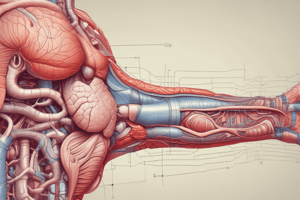Podcast
Questions and Answers
List two functions of the tongue.
List two functions of the tongue.
Taste food, aids with chewing and swallowing of food
What is mastication?
What is mastication?
Chewing and grinding of the food by the teeth
Three pairs of salivary glands, the _____, _____, and the _____ produce saliva that _____ the mouth during speech and chewing and _____ food so it can be swallowed easily.
Three pairs of salivary glands, the _____, _____, and the _____ produce saliva that _____ the mouth during speech and chewing and _____ food so it can be swallowed easily.
parotid, sublingual, submandibular, lubricates, moistens
Saliva also contains an enzyme called _____, which begins the chemical breakdown of _____ or _____.
Saliva also contains an enzyme called _____, which begins the chemical breakdown of _____ or _____.
After the food is chewed and mixed with saliva, it is called a/an _____.
After the food is chewed and mixed with saliva, it is called a/an _____.
What is the wavelike involuntary movement of muscles that causes the food to move in a forward direction through the digestive tract?
What is the wavelike involuntary movement of muscles that causes the food to move in a forward direction through the digestive tract?
List four things that happen in the stomach during digestion.
List four things that happen in the stomach during digestion.
What does maltase do?
What does maltase do?
What does sucrase do?
What does sucrase do?
What do peptidases do?
What do peptidases do?
What is the function of bile?
What is the function of bile?
What does pancreatic amylase do?
What does pancreatic amylase do?
What does trypsin do?
What does trypsin do?
What does lipase do?
What does lipase do?
Fingerlike projections in the small intestine, called _____, contain _____ and _____.
Fingerlike projections in the small intestine, called _____, contain _____ and _____.
The blood capillaries absorb most of the _____, while the lacteals absorb most of the digested _____.
The blood capillaries absorb most of the _____, while the lacteals absorb most of the digested _____.
List three functions of the large intestine.
List three functions of the large intestine.
Name the four divisions of the colon.
Name the four divisions of the colon.
List five functions of the liver.
List five functions of the liver.
What is the function of the gallbladder?
What is the function of the gallbladder?
What is the glandular organ behind the stomach?
What is the glandular organ behind the stomach?
What two secretions does the pancreas produce?
What two secretions does the pancreas produce?
What is hepatitis?
What is hepatitis?
What is diarrhea?
What is diarrhea?
What is cholelithiasis?
What is cholelithiasis?
What is cirrhosis?
What is cirrhosis?
What are hemorrhoids?
What are hemorrhoids?
What is ulcerative colitis?
What is ulcerative colitis?
What is gastroenteritis?
What is gastroenteritis?
What is a hiatal hernia?
What is a hiatal hernia?
Differentiate between type A, type B, and type C hepatitis. Why must health care workers be concerned about these diseases?
Differentiate between type A, type B, and type C hepatitis. Why must health care workers be concerned about these diseases?
Flashcards are hidden until you start studying
Study Notes
Functions of the Tongue and Saliva Production
- The tongue is essential for taste perception and assists in chewing and swallowing.
- Salivary glands include the parotid, sublingual, and submandibular, producing saliva to lubricate the mouth and facilitate swallowing.
- Saliva contains salivary amylase, an enzyme that initiates the breakdown of carbohydrates and starches.
Mastication and Bolus Formation
- Mastication refers to the chewing and grinding of food, crucial for preparation for digestion.
- After thorough chewing and mixing with saliva, the food forms a bolus, ready for swallowing.
Digestive Processes in the Stomach
- The stomach converts food into chyme, aiding in iron absorption.
- Enzymes like pepsin initiate protein digestion, while rennin specializes in digesting milk in infants.
Digestive Enzymes in the Small Intestine
- Maltase and sucrase break down sugars into simpler forms for absorption.
- Peptidases finish digesting proteins, while bile emulsifies fats, aiding in their digestion.
- Pancreatic amylase breaks down sugars chemically; trypsin targets proteins, and lipase handles fats.
Nutrient Absorption Mechanisms
- The small intestine features villi, fingerlike projections that contain blood capillaries and lacteals.
- Blood capillaries absorb most digested nutrients, while lacteals primarily absorb fats.
Large Intestine Functions
- The large intestine absorbs excess water and remaining nutrients, stores indigestible materials, and transports waste from the body.
Colon Divisions
- The colon consists of four sections: ascending, transverse, descending, and sigmoid colon.
Liver Functions
- The liver plays multiple roles: secreting bile, storing glycogen, iron, vitamins, and producing heparin.
Gallbladder and Pancreatic Functions
- The gallbladder stores and concentrates bile necessary for fat digestion.
- The pancreas, located behind the stomach, produces pancreatic juice and insulin for digestion and carbohydrate metabolism regulation.
Common Digestive Disorders
- Hepatitis refers to liver inflammation, typically viral.
- Diarrhea is characterized by frequent watery stools, often indicating digestive issues.
- Cholelithiasis involves stones in the gallbladder, while cirrhosis is a chronic liver disease marked by scar tissue replacement of liver cells.
- Hemorrhoids consist of swollen veins in the rectal area, and ulcerative colitis involves inflammation and ulcer formation in the colon.
- Gastroenteritis refers to inflammation of the stomach and intestinal mucous membranes.
- A hiatal hernia occurs when the stomach protrudes through the diaphragm near the esophagus.
Hepatitis Types
- There are three types of hepatitis: A, B, and C, caused by different viruses, with varying symptoms and liver effects, highlighting the importance of health care vigilance.
Studying That Suits You
Use AI to generate personalized quizzes and flashcards to suit your learning preferences.




